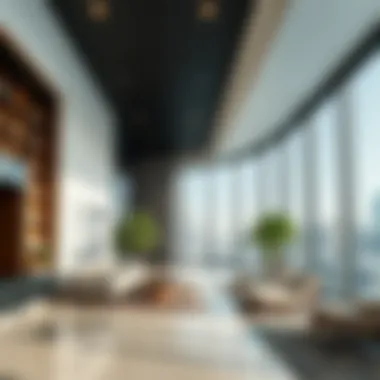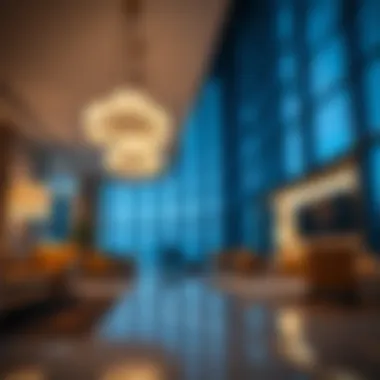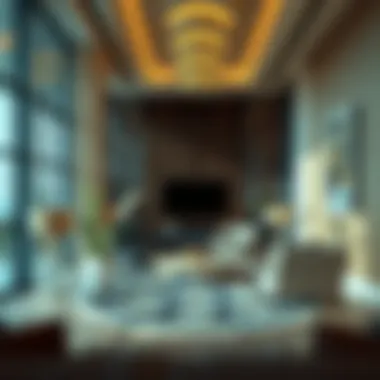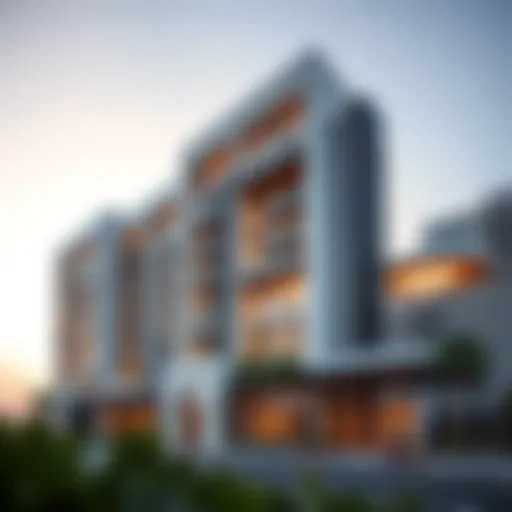Role of Interior Consultants in Dubai's Property Market


Intro
In the bustling metropolis of Dubai, interior consultants are playing a vital part in shaping the real estate narrative. As the market evolves, these professionals bridge the gap between aesthetic appeal and functional design. They delve into the multicultural fabric of the city, addressing not just the needs of developers but also the desires of residents from around the globe. Investing in Dubai’s real estate is a complex journey, and understanding the role of interior consultants can provide a significant edge throughout this expedition.
Through keen insights, they influence how spaces are designed, blending concepts that respect both tradition and modernity. When you think of a luxurious apartment in Downtown Dubai or a contemporary office in Business Bay, it’s often the touch of an interior consultant that transforms a mere structure into an inspiring space. Let’s dive deeper into the current market trends that dictate the dynamics of Dubai’s real estate landscape.
Market Trends in Dubai Real Estate
Current Market Overview
The real estate sector in Dubai has witnessed remarkable changes over the past few years. With the Expo 2020 behind us, the city is on a trajectory of recovery and growth. Properties are now riding a wave of confidence bolstered by government initiatives aimed at attracting foreign investment.
The mix of residential and commercial properties showcases stunning designs and sustainable practices, focusing greatly on the experience of the end-user. Interior consultants emerge as essential players, helping to interpret these trends into tangible outcomes that influence not only market success but also lifestyle satisfaction.
Price Trends and Forecasts
When examining price trends, it’s essential to consider several factors:
- Supply and Demand: A consistent influx of new properties creates a competitive market, but the demand from investors often keeps prices buoyant.
- Location, Location, Location: Hot spots such as Palm Jumeirah and Dubai Marina typically see premium pricing. Meanwhile, areas like Dubai South are emerging as more affordable yet promising.
- Sustainability: With a growing emphasis on eco-friendly designs, properties that incorporate sustainable practices, championed by interior consultants, often command higher prices.
Despite various fluctuations, experts predict a steady increase in property prices over the next few years, driven by ongoing demand from both locals and expatriates.
Investment Opportunities
Hot Areas for Investment
Investors looking to capitalize on Dubai's real estate market should keep an eye out for emerging neighborhoods. While established areas will always hold value, the following zones are gaining traction for their growth potential:
- Dubai Creek Harbour: This is becoming a focal point of development, blending leisure and living extraordinarily.
- Jumeirah Village Circle (JVC): Known for affordability and community feel, it’s a favorite for both families and singles.
- Dubai Hills Estate: With its vast green spaces and proximity to major highways, this area is transforming the idea of urban living.
Rental Yield Analysis
Understanding rental yields is crucial for investors wanting to make savvy choices. Some areas yield impressive returns, such as:
- Dubai Marina: This popular area generally achieves yields around 7-9%.
- Downtown Dubai: While prices are high, the demand keeps yields between 5-7%, a solid return considering the luxury appeal.
- International City: A more budget-friendly option, it often sees yields of 8-10%, particularly appealing for those seeking value.
When considering where to invest, consulting with interior professionals can provide unique insights into how design choices impact rental desirability and market performance.
Ending
For more detailed insights embarking on this fascinating journey in Dubai's real estate, consider exploring resources such as
Embrace the evolving story of this city, where every design choice reverberates far beyond the walls of the space itself.
Foreword to Interior Consultancy in Dubai
The role of interior consultants in Dubai's real estate is like a compass guiding the precise aesthetic and functional outcomes fundamental to successful living and working environments. As the city undergoes rapid transformation, with a vast array of residential and commercial structures evolving, the need for skilled interior consultants has never been more apparent. These professionals not only create delightful interiors but also ensure that these spaces meet the diverse needs of clients while abiding by the city’s regulations and cultural norms.
Understanding the Industry's Framework
The industry’s framework is complex, influenced by a melting pot of cultures and design philosophies. Interior consultancy in Dubai is nestled within a rapidly expanding real estate market, marked by skyscrapers that scrape the sky, vibrant shopping centers, and luxurious homes designed for the elite. This environment necessitates a profound understanding of both local and international design principles.
Interior consultants operate within this framework by engaging closely with developers, architects, and clients. It’s essential for these professionals to remain agile, adapting to market shifts and client preferences. They often rely on an array of tools and methodologies to deliver designs that not only reflect an individual’s taste but also enhance the functionality and utility of spaces. This includes understanding zoning laws, sustainability considerations, and emerging design technologies.
Moreover, Dubai’s interior consultancy landscape thrives on networking and collaboration. Consultants often form teams around a specific project to ensure a holistic approach. This multi-faceted work environment suggests that any interior consultant worth their salt thrives on communication, teamwork, and a keen eye for detail.
Historical Context of Interior Design Practices
To appreciate the current state of interior consultancy in Dubai, one must reflect on its history. From the early days of modest residences influenced by Arabic architecture to the contemporary lavish palaces and modern apartments equipped with state-of-the-art amenities, interior design has evolved considerably.
Historically, traditional design mirrored the cultural and environmental realities of the UAE. Materials like mud and plaster were predominant, resulting in structures adapted to the warm climate and lifestyle needs of the region. With the boom in oil resources and international investments, a shift occurred in the late 20th century, ushering in modernism to Dubai’s décor.
Summary
Overall, understanding the historical and current framework is fundamental for interior consultants as they navigate their profession in today's landscape. As styles interweave and functional needs grow more complex, the role of consultants will likely become increasingly vital. The interplay between tradition and contemporary style provides a rich context for innovative design concepts. Each project isn’t just about aesthetics; it’s about telling a story through the carefully curated spaces that make up Dubai today.
Roles and Responsibilities of Interior Consultants


The work of interior consultants goes far beyond just selecting paint colors or arranging furniture. In Dubai’s rapidly evolving real estate sector, their contributions carry significant weight. As the market continues to diversify, the role of these specialists becomes increasingly vital. They transform spaces not only for aesthetic appeal but for functional practicality.
Design Concept Development
Design concept development is the backbone of any successful interior consultancy project. This phase involves deep research, an understanding of the client's vision, and an assessment of the physical space at hand. The consultant often initiates this journey by conducting a thorough analysis of the environment, taking into account everything from natural light sources to architectural styles.
Through brainstorming sessions and mood boards, the consultant starts to weave the client’s requirements with practical outcomes. For instance, a beachfront apartment in Jumeirah would demand a different vibe compared to a corporate office in the Dubai Financial District. The interior consultant curates an approach that balances trends while adhering to timeless elements. Achieving harmony between style and function is crucial; after all, a beautifully designed space that lacks usability won’t hold much value.
Project Management and Coordination
Project management is another core responsibility for interior consultants. They often wear multiple hats, acting as the main point of contact between various stakeholders, including the client, contractors, and suppliers. Effective project management guarantees that all parties are on the same page, which minimizes the chances of miscommunication or delays.
Scheduling, budgeting, and quality control are just a few aspects that fall under this umbrella. A keen eye for detail enables the consultant to keep tabs on everything from the procurement of materials to the precise installation of design elements.
In Dubai, where rapid developments are the norm, sticking to deadlines can be a challenge. It’s often the interior consultant’s responsibility to ensure that unexpected issues are tackled promptly, keeping the project on track. They must adapt to changes quickly, making real-time adjustments to the plan without compromising on the initial design vision.
Communication with Stakeholders
Effective communication is the glue that holds all these roles together. Interior consultants must engage with several stakeholders, and each has its own expectations and requirements. Whether it’s reassuring a nervous client or negotiating with suppliers, adept communication skills are a must.
The consultant should gather feedback from clients frequently, keeping them in the loop throughout the design process. By doing so, they not only create a sense of involvement but also facilitate trust, which can be beneficial for future projects. Clear and concise communication is particularly important in Dubai, where clients may come from diverse cultural backgrounds, bringing unique perspectives and preferences.
Collaborative Dynamics with Developers and Clients
The collaborative dynamics between interior consultants and both developers and clients play a critical role in shaping the success of any real estate project in Dubai. Given the cosmopolitan nature of Dubai, the interactions in this landscape are not just transactional; they are layered with cultural nuances and unique expectations from every stakeholder involved. Interior consultants serve as the bridge between vision and execution, ensuring that the aspirations of clients merge seamlessly with the practical frameworks defined by developers.
The process begins with establishing a strong rapport. It’s not just about designing appealing spaces; it’s about creating a cooperative atmosphere where feedback flows freely. This environment fosters creative brainstorming, allowing for innovative solutions that might not emerge in a more hierarchical setting. Here are some key aspects that underline the importance of this collaborative approach:
- Clear Communication: All parties bring their own vocabulary and priorities to the table. Interior consultants must translate design jargon into relatable terms to ensure that clients and developers are on the same page.
- Shared Vision: Developing a shared vision requires the consultant to actively listen to both sides. It’s crucial to grasp the developer's long-term objectives, alongside the client's specific needs and aesthetic preferences.
- Resource Coordination: Successful projects involve pulling together various resources effectively. Interior consultants orchestrate this by liaising with contractors, suppliers, and regulatory bodies.
- Flexibility in Design: The collaborative atmosphere allows for agile design strategies. As the project progresses, inputs from developers and client feedback can lead to evolution in the design that may enhance usability or aesthetic appeal.
Creating Synergies: Architects and Engineers
When it comes to creating a successful environment, the old adage rings true—"Two heads are better than one." Interior consultants, architects, and engineers must work closely to streamline the design process. Each discipline contributes its strengths, which ultimately leads to a more cohesive outcome. For instance, architects focus on the broader spatial layout while interior consultants delve into detailing and furnishings. Engineers, dealing primarily with the functionality of structures, ensure that designs adhere to safety and operational standards.
The synergy among these disciplines is crucial. It ensures that aesthetic choices align with structural integrity. Projects in Dubai often involve grand designs that must hold up against both environmental factors and the test of time, making this collaboration invaluable. A regular dialogue regarding design intentions can prevent costly redesigns and delays later on.
Client Consultation Techniques
Consultation techniques practiced by interior consultants in Dubai are not just a checkbox activity; they are vital for ensuring client satisfaction. Initial consultations set the tone for the whole project, and employing a mix of formal and informal methods often proves effective. For example:
- Workshops or Focus Groups: Gather potential clients or stakeholders to discuss needs, expectations, and preferences. This participatory approach gives clients a sense of ownership over the design process.
- Surveys: Distributed questionnaires can capture detailed preferences without the pressure of face-to-face interaction. It’s an effective method to gather diverse opinions quickly.
- Visualization Tools: Utilizing mood boards or 3D rendering software allows clients to see concepts early on. This visual representation can bridge the gap between expectations and reality, making it easier for clients to articulate their thoughts.
By employing these techniques, interior consultants can create an environment where clients feel valued, heard, and understood, which in turn feeds back into the overall success of the project.
Handling Diverse Client Expectations
In a melting pot like Dubai, the diversity of client expectations is both a challenge and an opportunity. Interior consultants face the task of translating varied cultural influences into cohesive design concepts. Understanding clients’ individual backgrounds, preferences, and desires is paramount.
For instance, clients from Western backgrounds might lean towards minimalist aesthetics, while those from South Asian traditions might prefer more ornamental designs. Navigating these differences requires a keen sense of cultural nuances. To handle such diverse expectations effectively:
- Research Prior to Meetings: Understanding the general cultural inclinations of clients can enhance the relevance of design proposals.
- Empathy and Flexibility: Being empathetic to client feedback means treating it as constructive. Consultants might need to adapt designs based on the client's inputs, which helps build trust.
- Conflict Resolution Skills: With differences come conflicts. It’s essential for consultants to possess strong negotiation and mediation skills, ensuring that all parties feel their viewpoints are acknowledged while steering conversations toward mutual agreements.
Cultivating these collaborative dynamics not only elevates the design process but also enriches the overall experience for all stakeholders involved. As Dubai's real estate realm continues to evolve, the role of interior consultants in bridging gaps and aligning visions will remain crucial.
Cultural Influences on Interior Design
The interplay between cultural background and interior design is fascinating, particularly in a multicultural hub like Dubai. Here, interior consultants often draw inspiration from the city’s rich tapestry of traditions, integrating them into modern design practices. This blending not only enriches aesthetic appeal but also serves practical functions, making spaces more relatable and welcoming for those who inhabit them. Understanding cultural influences plays a crucial role for interior consultants in Dubai, primarily by ensuring designs resonate both emotionally and functionally with the diverse community.
As Dubai continues to attract a myriad of cultures, the importance of culturally influenced interior design grows. It allows for a sense of belonging among expats and locals alike while promoting storytelling through space. Interior consultants who embrace this cultural depth can tap into a limitless reservoir of creativity, ensuring that their designs echo the rich narratives of their environment.
"Every space tells a story. It’s our job to make sure it tells the right one for those who will live and work there."
Embracing Local Aesthetics and Traditions
Incorporating local aesthetics into design practices isn't just a trend; it’s a necessity in Dubai's vibrant real estate landscape. By reflecting the traditional architecture and artistry of the region, interior consultants can create spaces that honor Emirati heritage while boasting functionality. Elements such as intricate geometric patterns, the use of light as a design tool, and natural materials can all find harmonious places within modern settings.
When designing residential or commercial properties, consultants often explore local artistic motifs and materials. For instance, using traditional fabrics or local stone can add authenticity to the design. Clients are increasingly drawn towards spaces that not only look good but feel cultured. As a result, interior consultants who prioritize local culture in their designs stand out in a sea of options, enhancing property value as they do so.
Moreover, showcasing local artisans and their work in interiors promotes community and supports local economies. This can be a significant selling point for properties while fostering cultural richness within the real estate sector.


Balancing Modernity and Tradition
Striking the right balance between modernity and tradition can be a tightrope walk, particularly in a city known for its futuristic skyscrapers. Interior consultants in Dubai often face the challenge of modern clients who prefer sleek lines and contemporary styles while also wanting to pay homage to the rich cultural heritage of the region. Finding this middle ground involves strategic design decisions that respect tradition while embracing innovation.
To achieve this, consultants may adopt minimalist approaches that accentuate traditional elements, such as integrating local art pieces into modern spaces or using contemporary furniture that reflects traditional designs.
When done correctly, this fusion can create spaces that are not only visually striking but also tell a story, bridging the past with the present. Such an approach encourages prospective buyers and renters to appreciate the nuances within a space, enhancing their connection to both the property and its cultural backdrop.
Ultimately, as Dubai’s landscape evolves, so too does the responsibility of interior consultants. They are tasked with preserving cultural values while paving the way for modernity, ensuring that designs remain relevant and meaningful.
Sustainability in Interior Design
Sustainability has become a hallmark of contemporary interior design. In Dubai, where skyscrapers touch the clouds and luxury defines the skyline, one might think that sustainability takes a backseat. However, the reality is that interior consultants are increasingly weaving sustainable practices into their designs. This not only enhances the aesthetic appeal but also addresses pressing environmental concerns that resonate with investors, homebuyers, and real estate agents.
A core element of sustainable interior design is the consideration of the materials used. Selecting eco-friendly options goes beyond mere aesthetics; it reflects a conscientious choice to support environmental health. The long-term benefits associated with such decisions are numerous, like reducing waste and minimizing harm to ecosystems.
Eco-friendly Materials and Practices
When it comes to eco-friendly materials, the selection is vast. Interior consultants must navigate through options such as:
- Recycled furniture: This involves using existing materials creatively, reducing landfill waste.
- Low-VOC paints: These paints minimize harmful volatile organic compounds, ensuring healthier indoor air quality.
- Sustainable textiles: Fabrics made from organic cotton, bamboo, or hemp are gaining popularity for their low environmental impact.
- Composite materials: Utilizing materials like bamboo and reclaimed wood can offer aesthetically pleasing and sustainable designs.
Integrating these materials not only addresses environmental concerns but also caters to the growing consumer demand for sustainability. Many homebuyers now prefer spaces that showcase a commitment to eco-friendly practices.
Long-term Impact on the Environment
The long-term impact of sustainable interior design practices should not be underestimated. By incorporating sustainability, interior consultants play a crucial role in shaping the future of living and working spaces in Dubai.
Consider the impacts:
- Energy Efficiency: Thoughtful design can greatly reduce energy consumption. Natural light can be maximized through smart layouts, cutting down on the need for artificial lighting.
- Water Conservation: Sustainable interiors may feature water-efficient fixtures. This not only leads to lower bills for tenants but contributes positively to the city’s water sustainability goals.
- Waste Reduction: Sustainable practices often include strategies to minimize construction waste, and by using salvaged materials, they support a circular economy.
"The incorporation of sustainable practices in interior design can significantly influence buyers' decisions in Dubai's real estate market."
In sum, sustainability in interior design isn't simply a trend—it's an evolving necessity that reflects a societal shift towards more responsible living. As investors and buyers become more discerning about their choices, the demand for greener solutions will shape the future of interior consultancy. This progressive approach doesn't just benefit the environment; it can also drive long-term cost savings and enhance property value, making it a wise investment for all.
For further reading on sustainable architectural practices, consider visiting Wikipedia's entry on Sustainable Architecture or review reports from Green Building Council.
By embracing these sustainable principles, interior consultants are not just shaping spaces—they are sculpting a more sustainable future for Dubai.
Trends in Interior Consultancy in Dubai
The evolution of interior consultancy in Dubai is a reflection of both the fast-paced nature of the region's real estate market and the changing expectations of its clients. As the city continues to grow as a global business hub, trends within the interior consultancy space are also shifting. Understanding these trends is crucial for stakeholders, as they highlight the innovative approaches and responses to client needs in the market.
Technological Integration in Design Processes
Technology is at the forefront of the changes taking place in interior consultancy. Tools such as Building Information Modeling (BIM), virtual reality, and augmented reality are reshaping how designers communicate their ideas and concepts. Visualizing spaces through these technologies enables clients to experience a project before it comes to fruition. This not only enhances understanding but also encourages early feedback, which can mitigate misunderstandings later on.
"Embracing technology in design processes is no longer optional; it’s a necessity for staying competitive in Dubai’s bustling real estate landscape."
Digital tools also assist interior consultants in managing projects more efficiently. They help in logistics, timelines, and collaboration with various stakeholders, making sure that everyone is on the same page.
Shifts in Client Preferences
Clients today are more informed and discerning. They seek personalized designs that resonate with their identities and lifestyles. The days of one-size-fits-all solutions are fading fast. In Dubai, many clients are looking for interior consultants who can offer unique, customized solutions that reflect personal tastes while also responding to function and comfort.
This shift has given rise to an emphasis on sustainability and wellness in design choices. Clients are now choosing materials and designs that not only look good but also promote a healthier living environment. Factors like natural lighting, air quality, and the use of eco-friendly materials are increasingly requested during consultations.
Emerging Styles and Aesthetics
With the influx of diverse cultures and influences in Dubai, eclecticism in design has gained significant traction. Presently, definitions of aesthetics are evolving, incorporating elements from various cultural backgrounds. This merging of styles reflects the city's cosmopolitan nature. From minimalist European designs to opulent Middle Eastern aesthetics, the combinations are endless, allowing clients to craft truly unique spaces.
Additionally, there’s a growing inclination towards biophilic design, which emphasizes integrating nature into architectural environments. Living walls, natural materials, and organic forms are examples of how this trend is being embraced.
In summary, the trends in interior consultancy in Dubai demonstrate significant shifts driven primarily by technological advancements, client demands for personalization, and a fusion of cultural influences. Understanding these trends is essential not just for consultants but for investors and developers looking to make informed decisions in Dubai’s dynamic real estate market.
Challenges Faced by Interior Consultants
The realm of interior consultancy in Dubai is not always a smooth ride. Navigating the intricacies of this vibrant market presents unique challenges for interior consultants. Understanding these challenges is crucial, as they define the consultants' ability to adapt and thrive amidst evolving client preferences, regulatory frameworks, and market dynamics.


First and foremost, interior consultants must manage a blend of complexity in regulations and client demands. This is not merely a matter of artistic intuition; it's also about understanding the nitty-gritty of compliance and budget management.
Navigating Regulatory Frameworks
In any bustling metropolis like Dubai, regulatory frameworks establish the baseline for construction, safety, and aesthetic compliance. With the government’s consistent push towards modernization, compliances can morph swiftly, and interior consultants find themselves in a constant state of learning and adaptation.
The importance of staying updated cannot be overstated. For instance, building codes and safety standards may adapt based on the latest technologies or methodologies. Failure to adhere can lead to costly ramifications. Navigating these frameworks means understanding documents, forms, and permits that can sometimes feel like deciphering hieroglyphs.
Moreover, environmental regulations are gaining traction, pushing designers to weigh their material choices seriously.
"An interior consultant in Dubai must ensure that every design element not only meets aesthetic expectations but also adheres to stringent regulatory standards to ensure safety and longevity in the project."
This challenge extends to ensuring that the designs align with the cultural context of Dubai, creating spaces that are not only functional but also respectful of local traditions and values. Consultants often serve as the bridge between innovative design and grounded regulatory practices.
Managing Client Demands within Budgetary Constraints
Equally pivotal is the ability to manage client expectations, especially when financial considerations come into play. Unlike a blank canvas, clients have budgets that can dictate the course of a project. Interior consultants often work within tight constraints, balancing client dreams with realistic pricing.
Understanding a client's intent can be like reading the fine print in a contract; it requires patience and skill. From high-end residential projects in Dubai Marina to commercial spaces in Business Bay, each client has distinct needs. Managing these demands requires not just design expertise but also negotiation skills to help clients see the potential in choices that might initially seem out of scope.
- Prioritize Needs vs. Wants: Often, an initial luxury can turn into a must-have. Consultants need to guide them through this maze.
- Explore Cost-effective Solutions: Suggest alternatives that don’t sacrifice quality while adhering to the budget.
- Transparent Communication: Keeping clients in the loop about potential costs fosters trust and understanding.
By navigating these financial waters effectively, interior consultants can create spaces that are both stunning and within reach financially, transforming vision into reality without breaking the bank. In essence, while challenges abound, they also open avenues for interior consultants to showcase their adaptability and commitment to excellence.
Selecting the Right Interior Consultant
Choosing the right interior consultant can make or break the overall success of a project in Dubai's competitive real estate landscape. A well-selected consultant doesn’t just alleviate stress; they also ensure that the design and functionality of spaces resonate with desired aesthetics and meet client expectations. This could be the difference between a space that feels chaotic and one that flows harmoniously, echoing the needs of its occupants.
One of the first considerations in this selection process is understanding the consultant's previous work and specialty areas. Each consultant brings their unique flair, and it’s vital to assess whether their style aligns with the vision for your project. Often, this entails reviewing portfolios that showcase a range of completed projects. However, it's also crucial to focus on how they handle spaces similar to yours, particularly in Dubai where the nuances of residential and commercial segments can differ vastly.
Additionally, competitive metrics like project timelines, budgets met, and overall client satisfaction ratings often reveal much about a consultant's reliability and professionalism. Ignoring these factors might lead to unforeseen hurdles down the line. When considering a consultant, one should weigh the benefits of their expertise against the prospective costs. A seasoned consultant may command a higher fee, but this can lead to significant savings in time and money through efficient project management.
Selecting a consultant who understands your cultural context and personal style can enhance the project's integrity and effectiveness.
In the dynamic market of Dubai, where trends come and go, having a consultant who is not just skilled but also adaptable to changing tides is an invaluable asset.
Evaluating Portfolios and Expertise
When it comes to selecting the right interior consultant, evaluating their portfolio is a step that should be done with keen attention. The portfolio is essentially a mirror reflecting the consultant’s capabilities, creativity, and breadth of experience. Begin by asking for a collection of their previous works. This includes not only images and descriptions of projects but also client feedback or testimonials that underline their strengths.
- Look for diversity in their projects. Can they design both modern and traditional spaces? Do they have experience with residential projects as well as commercial spaces?
- Note any particular nuances in style—does the consultant favor minimalist designs, or do they tend to lean towards more ornate spaces? This is essential as it will set the tone for what you might expect.
- Pay attention to the functionality and usability of the spaces they’ve designed. A visually appealing space is one thing, but it must also serve its purpose effectively.
Moreover, it’s wise to ask about specific challenges faced in past projects and how the consultant overcame them. This discussion can give insights into their problem-solving skills, a critical element in the often unpredictable world of interior design.
Conducting Interviews and Assessing Compatibility
Once you've narrowed down your options, conducting interviews with potential consultants is crucial. This is where you get a feel for their personality, approach, and compatibility with your vision. The best consultants aren't simply skilled designers; they’re also adept at listening to client needs and translating those into actionable plans.
During the interview:
- Prepare clear questions concerning their design process. How do they approach projects from the initial consultation to completion?
- Discuss your project in detail, gauging their responses and suggestions. Their level of enthusiasm and insight can tell a lot about their potential contribution.
- Compatibility goes further than just design preferences; it’s also about finding someone who communicates well and with whom you feel comfortable. The best results often stem from a strong collaborative partnership.
It is advisable to involve other stakeholders if applicable, as their perspectives might reveal additional compatibility or differences in expectations that must be addressed before commencing the project.
Ultimately, selecting the right interior consultant is not a trivial task. It requires due diligence—assessing portfolios, interviewing candidates, and ensuring that the consultant's vision aligns with yours. In Dubai’s bustling real estate scene, where every detail counts, making this choice thoughtfully can lead to extraordinary outcomes.
Future Directions in Interior Consultancy
The landscape of interior consultancy in Dubai is ever-evolving, influenced by a myriad of factors such as technology, market demands, and cultural shifts. Understanding future directions in this realm is crucial for investors, homebuyers, and real estate agents seeking to navigate the intricate dynamics of the city's property market. As we delve into these future directions, it becomes clear that interior consultants play a vital role in shaping not just the physical spaces but also the user experience within those environments.
Anticipating Market Evolutions
Dubai’s real estate market is known for its rapid changes. For instance, shifts in buyer preferences, influenced by global events or local economic conditions, can necessitate adjustments in design and functionality. Interior consultants must remain vigilant, keeping their fingers on the pulse of these trends.
- Demographic Shifts: As younger generations enter the housing market, their design preferences may differ vastly from those of previous generations. This might involve a growing preference for minimalistic designs, sustainable materials, and adaptable spaces that can serve various functions.
- Urbanization Trends: With more people flocking to urban areas, there's a demand for innovative designs that maximize space. This trend can lead to a rise in consultancy projects focused on multifunctional environments that blend living, working, and recreational spaces.
- Economic Influences: The market is also sensitive to economic fluctuations. For example, a downturn could shift focus from luxury to budget-friendly interiors, prompting consultants to adjust their strategies accordingly.
"The ability to forecast trends can significantly enhance an interior consultant's value, ensuring that their designs resonate with current and future demands."
Innovations in Design Practices
Innovation is the lifeblood of progress in any field, and interior consultancy is no exception. Adopting new technologies and methodologies not only improves efficiency but also enhances the overall quality of designs.
- Integration of Smart Home Technology: Today’s homes are becoming increasingly smart. From automated lighting to temperature control systems like Nest, incorporating these technologies into design not only caters to client preferences but also creates spaces that are more energy-efficient.
- Virtual Reality (VR) and Augmented Reality (AR): These technologies allow interior consultants to provide clients with immersive experiences. They can walk through their future spaces before anything is built, making alterations easier and enhancing client satisfaction.
- Biophilic Design: This approach focuses on connecting people with nature. Interior consultants are increasingly using natural materials and biophilic patterns to make spaces more inviting, improving overall well-being.
Through these innovative practices, interior consultants can ensure their designs are not just relevant today but are built with foresight into future changes in lifestyle and technology. By adapting to these shifting tides, they can effectively meet the demands of a vibrant and competitive market.















